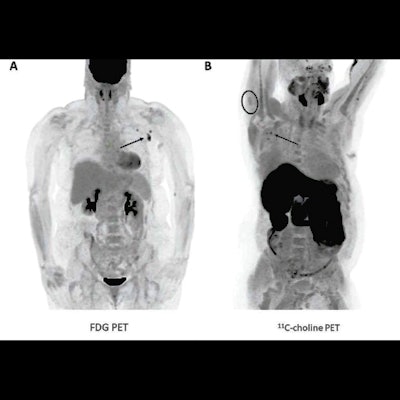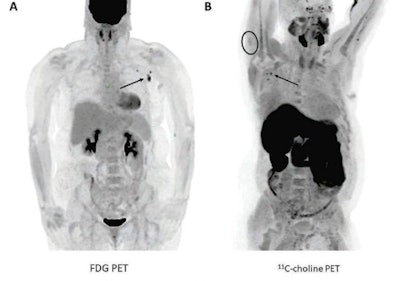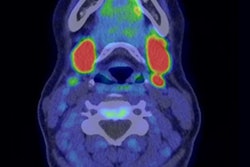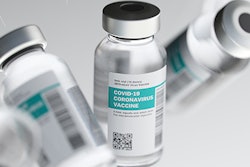
PET imaging showed abnormal radiotracer uptake in the lymph nodes of cancer patients after they received COVID-19 vaccinations in a new study published May 20 in the American Journal of Roentgenology. The finding suggests the phenomenon may confound image interpretation and lead to unnecessary biopsies.
Researchers at the Mayo Clinic in Rochester, MN, compared PET scans of patients before and after they received Pfizer-BioNTech or Moderna COVID-19 vaccinations and observed increased FDG and carbon-11 (C-11) choline uptake by axillary lymph nodes and ipsilateral deltoids. There had been no visible axillary node uptake prior to the vaccinations.
"These alterations in PET findings after COVID-19 vaccination are important confounding pitfalls that could prompt unnecessary biopsies and treatments unless appropriately recognized by interpreting physicians," wrote first author Dr. Dane Schroeder, a diagnostic radiologist.
Recent multiple case reports and small studies have demonstrated COVID-19 vaccinations with the Moderna and Pfizer products produce minor side effects, including reactive lymphadenopathy. To date, systematic analysis of changes on PET due to COVID-19 vaccination is limited. The management of FDG-avid lymph nodes in patients who have been vaccinated presents a clinical challenge, particularly given the common application of PET imaging in oncology, according to the authors.
In this retrospective analysis, researchers sought to evaluate the frequency and characteristics of abnormal FDG and C-11 choline uptake on PET imaging performed on cancer patients after COVID-19 vaccination.
The study included 67 patients who had PET/CT or PET/MRI examinations with FDG or C-11 choline between December 14, 2020, the first day vaccines were available in the U.S., and March 10, 2021. PET was performed a median of 13 days after vaccination in patients who had received one dose and 10 days after vaccination in patients who had received two doses.
Two nuclear medicine physicians independently reviewed the images. Lymph node and deltoid maximum standardized uptake values ( SUVmax) greater than blood pool SUVmax were considered positive. All of the C-11 choline PET examinations were performed on patients for prostate cancer evaluation.
The researchers observed positive axillary lymph node uptake in 10.4% (7/67) of patients on FDG-PET examinations and 23.1% (3/13) of patients who underwent C-11 choline PET imaging. Ipsilateral deltoid uptake was present in 14.5% (8/55) of patients with documented injection laterality, including in 42.9% (3/7) of patients with positive axillary lymph nodes.
 (A) A 57-year-old woman with right upper arm melanoma who received the first dose of the COVID-19 vaccine (Pfizer-BioNTech) in the left deltoid 15 days prior to FDG PET/CT. FDG uptake is observed within left axillary lymph nodes (arrow, SUVmax = 9.3). (B) A 62-year-old man with metastatic prostate carcinoma who received the second dose of COVID-19 vaccine (Pfizer-BioNTech) in the right deltoid seven days prior to C-11 choline PET/CT. Image courtesy of the American Journal of Roentgenology.
(A) A 57-year-old woman with right upper arm melanoma who received the first dose of the COVID-19 vaccine (Pfizer-BioNTech) in the left deltoid 15 days prior to FDG PET/CT. FDG uptake is observed within left axillary lymph nodes (arrow, SUVmax = 9.3). (B) A 62-year-old man with metastatic prostate carcinoma who received the second dose of COVID-19 vaccine (Pfizer-BioNTech) in the right deltoid seven days prior to C-11 choline PET/CT. Image courtesy of the American Journal of Roentgenology."We did not observe any PET-positive axillary lymph nodes beyond 24 days after vaccination. Thus, waiting 3-4 weeks after vaccination before undergoing PET examination for initial oncologic evaluation may also be reasonable, particularly in patients at greater risk of axillary nodal disease," the authors wrote.
In addition, to help avoid pitfalls interpreting PET imaging at the Mayo Clinic, the researchers have implemented a new process to verbally screen patients for their vaccination histories prior to PET examinations, since that information is not always readily available in their charts. The screening data is entered into the patient's chart and made available to the interpreting physician.
"Interpreting physicians should recognize characteristics of abnormal uptake on PET after COVID-19 vaccination to guide optimal follow-up management and reduce unnecessary biopsies," Schroeder and colleagues concluded.





















